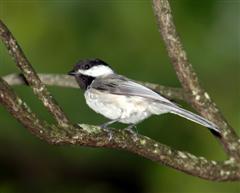Chickadee - Black Capped
Scientific Name: Parus atricapillus
Tue, 29th April, 2025 - 3:49 pm GMT
Sponsor Ads:

Alternative Name
Scientific Name: Parus atricapillusBasic Info
The Black-Capped Chickadee is adorned with a black cap over its head and a black throat. Its back is gray in color, with a soft white beneath its wings and white cheeks. The wing feathers are dusted at the edges with a similar soft white. Its voice has a buzzing tone to it, quiet and subdued, in contrast with its behavior. The average mature adult will read five inches (13 centimeters)in length.
Health
One of the great things about these birds is how friendly they are; few birds are this taken with humans and they will be pleased to make their winter home in your backyard, provided you give them enough material to do it. Black-Capped Chickadees will thrive in conditions that include vines, pine trees, birch trees, and Woodbine. They will be naturally attracted to feeders that include black oil sunflower seed and peanuts. It is also reported that they prefer swinging feeders. These Chickadees are omnivorous and they eat approximately 70 percent insects and 30 percent plant matter, seeds etc. They feed mostly on small insects, beetles, caterpillars and ants. They are also known to eat spiders and spider eggs. Birdbaths will keep their thirst quenched and their babies healthy, and adding a heater to the birdbath will make life bearable for them during the colder winter months. They will eat from your hand if you're gentle enough about it - try a handful of peanuts and slow, calm movement forward to let them know you're friendly. Breeding They will gladly make their nests with feathers, twigs, leaves, and wool and possibly begin to raise eggs there. The nests will usually be upwards of ten feet off the ground. Eggs take around 15 days to incubate.The chicks will take flight at around 16 days old, but remain with their parents until about 28 days old . You'll be able to take a passive role in watching these playful birds come to life.Habitat
N/ABehavior
With a cheerful chirp and a quick dart of the legs, the Black-Capped Chickadee is a fascinating bird to watch from afar, and it is friendly enough to interact with in your own backyard. Finding their homes mostly in the rotting sections of birch and pine trees, your backyard can be a perfectly suitable home for these friendly birds. One of the best things about these adorable little birds is that they love to do various acrobatic tricks. At any time during the day, they can be seen hanging upside-down from trees, flipping about in the air, or darting around on the ground with lightning-fast speed. They are known to migrate mostly to the Southern United States in the wintertime and will be found in abundance during the winter months. Flocks will come in large numbers, so be prepared for an invasion, if your backyard is particularly inviting. If you are looking to provide a perfect home, old woodpecker nests or birdhouses will work wonderfully for the Black-Capped Chickadee, provided you have plenty of feathers, twigs, leaves, and wool around.Origin
North AmericaHistory
An interesting fact about the black-capped chickadee is that it is strikingly similar to the Carolina chickadee. Crossbreeding among the two species is very common and there are certain types of both breeds that cannot be classified as being part of either breed. The ranges of both birds are also similar, resulting in a lot of coexistence, but you can still tell the difference between the two. The Carolina variety will sing four notes and the Black Capped Chickadee will sing only two. Also, the Black Capped Chickadee will be a bit larger, with slightly different coloration around the edges of the wings.Common Foods
feathers, twigs, leaves, and woolSponsor Ads:
The universe doesn't always give you what you want. It gives you what you need.
Chickadee - Black Capped
Coded by: BGID® | ALL RIGHTS RESERVED Copyright © 2000-2025
Disclaimer | Privacy | Report Errors / Contact | Credits








 President of the United States of America - Real Estate mogul, Pageant owner and now one of the most controversial men in political history.
President of the United States of America - Real Estate mogul, Pageant owner and now one of the most controversial men in political history.  Politician, US Vice President and President of the USA - Joseph Robinette Biden Jr.
Politician, US Vice President and President of the USA - Joseph Robinette Biden Jr.  versus
versus  Russia: 'The Evil Empire'? Are they all that bad or is it just the USA trying to portray Russia as bad because they are a world power with land bigger and a society very different from the USA ideal?
Russia: 'The Evil Empire'? Are they all that bad or is it just the USA trying to portray Russia as bad because they are a world power with land bigger and a society very different from the USA ideal?  Global warming has been in and out as the "latest" hot topic for many years. It is, according to modern scientists, the result of man-made industrial pollutants, clearing forested areas, agriculture, etc. But now they are thinking it started way before the Industrial Revolution...
Global warming has been in and out as the "latest" hot topic for many years. It is, according to modern scientists, the result of man-made industrial pollutants, clearing forested areas, agriculture, etc. But now they are thinking it started way before the Industrial Revolution... 
 Corona virus
Corona virus 
 Users with wide screen monitors can benefit from more content on every page.
Users with wide screen monitors can benefit from more content on every page.